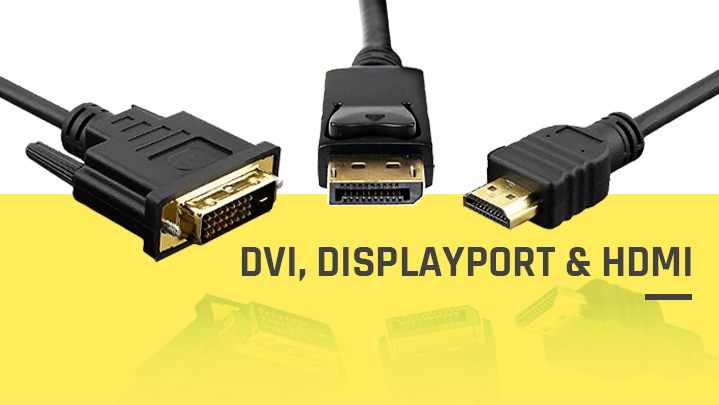DisplayPort, DVI-D, or HDMI cable connection.
It's important to understand that each connection has its pros and cons. Sometimes the best cable for your display is actually what it came with, sometimes it isn't.
It's also important to note that with the exception of VGA, all the connections here are within the digital realm. While the pixel resolution varies with each connection type, the quality does not. A 1080P/60 over HDMI is going to look the same as a 1080P/60 DVI and DisplayPort. The cables themselves don't make much of a difference, it's the technology behind them that do.
DisplayPort
DisplayPort is a computer connection cable. There aren't many--if any--TVs that carry this port but in the future that may change. The DisplayPort cable is capable of 2160P resolution at 60 FPS if you have DP 1.2 and the multi-stream transport feature. From machine to display, the DisplayPort will work just fine. There's not much of a reason to not use the DisplayPort unless your monitor wants to push more than 60FPS. In some gaming scenarios, this may be true, in which case, you would go with the DVI-D cable to push those higher resolutions at better FPS. Pricing wise the cable is around the same as an HDMI cable, and it also carries audio.
HDMI
Most TVs and most computer monitors have HDMI input capabilities. It's really easy to use, carries audio, and ranges from $2 to $20! If you're plugging in anything, your first choice should generally be HDMI because of the wide range of use cases; many devices carry it as a primary input type. HDMI has limitations, however, it's not always the best quality for the choice and it will have restrictions on its FPS over higher resolutions.
HDMI 1.4 connections max out at 2160P resolutions at only 30FPS. If you're looking into a 4K monitor, you definitely want to have a DVI-D or DisplayPort to support higher than 30FPS on your screen. In the future, HDMI 2.0 will be out and it will handle 4K over 60FPS but you will also need to upgrade your hardware to support this. In most cases, HDMI is fine and is at a great price point, there are some cases when you want to use DisplayPort or DVI-D (dual-link) to push the proper FPS to the display at the resolution of your choice.
DVI
The DVI cable is basically the same as HDMI, and the maximum resolution depends on the equipment. Some cable and hardware called single-link can only do 1200P, but dual link technology can handle much more. DVI doesn't handle audio, but it can vary, and you wouldn't want to use the DVI cable for TVs even if they have them. HDMI is generally much more affordable and can handle audio most of the time.
Conclusion
HDMI is usually the best bet in 80% of these three cable options. Make sure to do proper research on whichever cable you want to use, as the best is in understanding the appropriate technology. High-resolution monitors and displays require better digital connections with the appropriate technology. Most 4K gaming monitors will require DVI-D or DisplayPort. So save some time and cash and make sure you choose the right cable!


